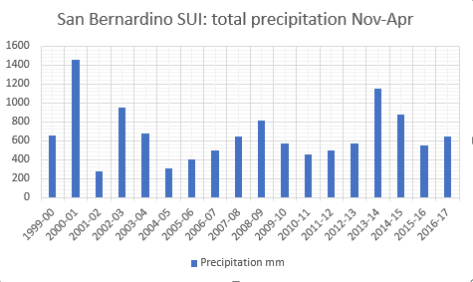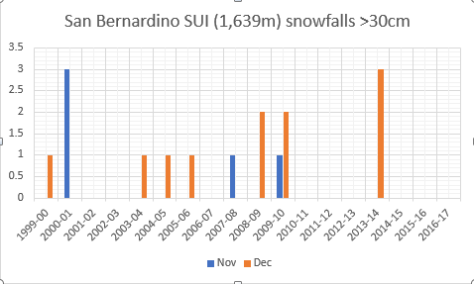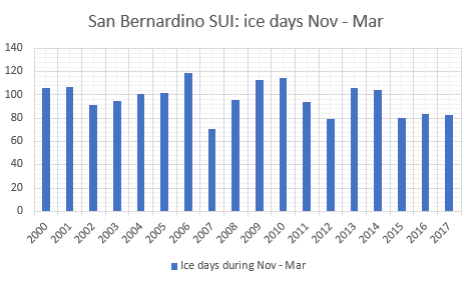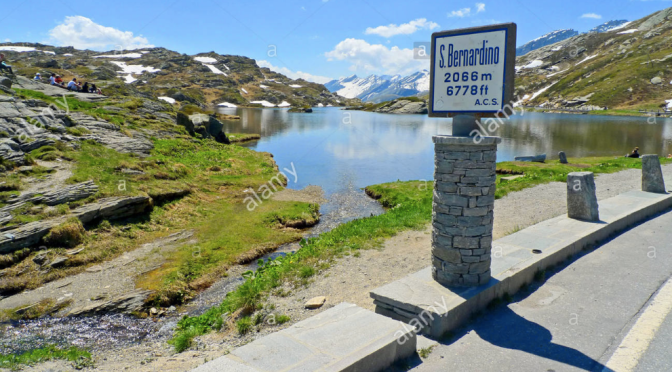The Alpine snowfall season finished just below average in the Splügen area of the Swiss Alps. Abnormally warm weather after decent snowfalls in February and March curtailed the season; mean temperatures finished over a degree warmer than average between November and April.
The figures make depressing reading for anyone who enjoys winter sports and come after a study suggested that bare Alpine slopes could become a much more common sight in the future.
I first visited this area of the Alps in 1981, returning most February half-terms, apart from 1989 when the snows failed to arrive until after Easter. The season that hastened the installation of artificial snowmaking in resorts across Europe has always left me wondering just how much snowfall has varied.
Using San Bernardino, a village at 1636m in the southwest of Grisons canton, I had a look at temperature and rainfall data back to 1999 to see what patterns were present. The figures confirm that some years see metres fall while others have barely enough to cover the pistes.
Temperatures, meanwhile, show a general upward tick from 2005-06.

While the above graphs show typical variability they don’t reveal much about month to month conditions.
Closer scrutiny of the data shows that early season dumps of over 30cm, the kind that really get the snow bases going and keep the earth below chilled for a long season, are becoming rarer. Indeed, apart from a blip in 2013/14 there have been no big early season dumps since 2009/10. The seasons are taking much longer to get going.


As the second graph shows big dumps of snow are happening later in the season. If there is not already a decent snow base these snowfalls can thaw much faster because spring sunshine has already warmed the ground.
Another way of trying to find how the climate has changed is to look at how many ‘ice days’ there were in a given period – ice days are when the maximum temperature reaches -0.1C or lower over 24hrs.
The graph below shows the past three years have been fairly constant though this season’s total of 83 is 37 days fewer than the highest total in the series, 2005-06 which clocked up 119 days.

I’ve visited many resorts in the Alps which, obviously, will be affected differently by the changing climate – the range of microclimates in the Alps is staggering.
In conclusion, considering the data and my experience, I’d say that though the Alps have definitely warmed the variability and ebb and flow of the climate means it is impossible to say with confidence that by the end of this century the slopes won’t be covered in the white stuff.
I chose San Bernardino because it is fairly central in the entire Alpine range and is also the most local SYNOP station I can find to the Valtellina range that I have been visiting most years since 1981. Any climatologists reading this would point out that my data range does not stretch back the necessary 30 years to make a judgment on the stats. If anyone can point me to a site that offers data back to 1980 I would happily update my figures and graphs.
My trip this year to Madesimo, 8 miles as the crow flies from San Bernardino, was timed just right for a dump of snow in February that followed weeks of dry weather.

The area has enjoyed some epic snowfalls over the years including 2013/14 when many found themselves snowed-in following a 2m dump of snow. The first of many snowfalls during what was an epic season.
Here is a timelapse of the huge 2m snowfall in Madesimo over Yuletide 2013








My own experience the last few years has been that later skiing works out more reliably. Then again I try to stick to high resorts like Val Thorens. We did spend a day in Sestriere last October but it was a ghost town. The mountains around that region are just as spectacular without snow though, so not a wasted trip!
“Funnily” enough I got interested in the whole topic of climate “science” about 10 years ago because I was trying to convince a friend that we needed to do more skiing before the Alps were snow free! He argued that there was contradictory data but I was so confident he was wrong that I offered a wager I could easily produce many authoritative papers backing up the famous Gore movie. I went away to do exactly that, thinking it would be the proverbial “taking candy from a baby”.
The rest is history of course but suffice to say that he was right and the experience ruined a great part of my succeeding years having to observe and pay for (!) the nonsense being spouted by so called climate scientists and their acolytes in the main stream media. The thing that makes me really angry are the excessively expensive and positively dangerous policy outcomes, pushing the poorest into real fuel poverty and, picking up on of your other posts, promoting diesel as clean.
As a result I no longer have any confidence at all in the main stream media (particularly the BBC), public policy making in science and, extrapolating from that, in any area where an analytical evidence based approach is required. The scientific method and proper journalism seem to be in a downward death spiral and it’s difficult to see how that can work out well.
Apologies for the negativity, feel better for getting it off my chest though!
Thanks for the opportunity.
LikeLiked by 1 person
I think unless these people can change the laws of physics, skiing / boarding etc in resorts with plenty of terrain above 2,000m will still be possible 100 years from now.
Of more concern I think is the possible shifting of rainfall patterns across the world. Many European resorts without the massive investment in snow making since the late 1980s would have been unable to have offered any skiing for a big chunk of the last season.
Of course, as water becomes more scarce and, therefore, more expensive, there will be questions of cost as well as a growing environmental lobby concerned over the ethics of spraying a precious resource on to mountain slopes for the benefit of a few rich tourists.
Those lifts also consume a hell of a lot of energy. Lift passes are already very expensive compared with two decades ago – how long before these are just not sustainable, at least in the smaller resorts?
I prefer the smaller resorts to behemoths such as Val d’Isere, Trois Vallees etc. There’s obviously not as much terrain but you are still ‘in the mountains. The locals work harder and seem genuinely pleased to see you.
Mountains aside I share your concern about how the message about the climate is getting lost by the media – I was quite shocked about how the Guardian wrote a piece on how storminess is going to increase in the UK using a study from 2009. Reading between the lines of this study it is almost like the Met Office is in cahoots with the insurance industry to increase already sky high premiums.
I was quite shocked by a response of a former Met Office worker who posted the following: “I’ll tell you what probably happened. A MetO Sales Consultant received a request from an insurance conglomerate or re-insurance business to provide them with the likely impact on UK of storms as a result of climate change.
Consultant then went to Climate department and asked if they could do it. They said yes for a price. Price agreed by business department and work schedule agreed. Climate dept. then handed this to a junior scientist (as they are cheap) and told to produce something. Scientist (who will not be a synoptician) produces something and voila we have a story full of cow poo.”
He later added: “I used to work there and know how things are done. I understand that you are trying to get a job there and good luck, but if you do get there you will quickly come to realize that Climate Change is a big money earner. Everyone wants to know how CC will affect there business/location and they ask the experts but often the answer is at best a guess but there is still a dollar to be made. The MetO is a business never forget that. Norman and others are right
ultimately it is the synoptic patterns that will be responsible for our
weather in the future, and the present climate models lack that precision.”
LikeLiked by 1 person
Have you seen Paul Homewood’s post on the labour manifesto? 60% low carbon by 2030. I would love to be a fly on the wall at a family gathering of the Corbyns.
LikeLike
I haven’t – though I’m intrigued that if JC is elected prime minister will he get his brother involved to shake up the Met Office and climate policy?
LikeLike
I doubt it – otherwise how could he have come up with such a hairbrained manifesto pledge? My brother hates Brexit and we have agreed not to discuss. Somehow I suspect if they are talking they will have taken s similar approach on this topic. At least I managed to change my brother’s mind on climate change!
LikeLike
Btw Aren’t the BBC droppeing the MO?
LikeLike
Their data is (or very soon will be) supplied by MeteoGroup
LikeLike
I hope not yet because our current forecasts here are pretty poor, though I may have unrealistic expectations. We live in the hills above Manchester so perhaps that is unreasonably challenging.
LikeLike
Looking at the graphics on the bulletin just now I wonder if the changeover has happened.
LikeLike
You might be right 😦
LikeLike